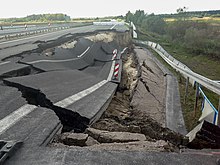Peat lens
A Torflinse , also called Moor lens is usually small, lens-shaped in cross section bog , which, however freiäugig is rarely recognized as such.
Peat lentils are found primarily in the lowlands of the glacial valleys of the Central European lowlands, such as in northern Germany , the Netherlands , Belgium and Poland .
Origin and origin of the name
Most peat lentils arose in small depressions as fens and have often developed into raised bogs over the course of several millennia . The formation in sandy or clayey depressions leads to cross-sections in the shape of a lens , which explains the name.
Many of these bog areas have either only been partially pitted or dug up in the last few centuries , or they have been covered with earth or sand. Therefore it is or was often not recognizable that they pose a threat to the stability of a building.
Hazards and detection
If buildings or traffic systems are erected on a peat lens without providing the foundations with a correspondingly deep foundation , there is a risk that the structure will later sag with the corresponding formation of settlement cracks .
As a rule, peat lenses are only discovered through these subsidence during building or road construction . Even then, it is time-consuming to determine their spatial extent, because they can occur in different thicknesses over a small area between layers of clay and sand. If there is a concrete suspicion, the investigation can be carried out geotechnically , for example with a load plate pressure test .
Examples
- The city of Rungholt was built on a peat lens and went under in the Second Marcellus Flood on January 16, 1362 due to the subsiding ground.
- Sections of the Neumünster – Flensburg railway line (course book line 131) were also built on a peat lens, which made it necessary to reduce the line speed and extensive renovation work after the lowering of the railway body.
- A peat lens was the undoing of the architect Andreas Schlueter (1660-1714). His mint tower in front of the Berlin Palace collapsed a few days after the opening, which angered the Prussian King Friedrich and marked the end of Schlüter's career.
- In 2017, the roadway of the Federal Motorway 20 towards the west at Tribsees sagged by half a meter into the boggy ground over a length of about 100 meters and was then closed in September 2017. At least two years were estimated for the repair. By October 2017, the affected lane sagged at this point over a length of 40 meters by more than two and a half meters and was thereby destroyed piece by piece across its entire width. According to the Minister of Transport, Christian Ebene , the cause of the incident is that the motorway at Tribsees runs over a peat lens that was stabilized with small concrete cores. These may not have withstood the load, the exact cause should be determined.
Web links
- Renovation of the Lottorf peat lense near Flensburg (PDF file; 157 kB)
